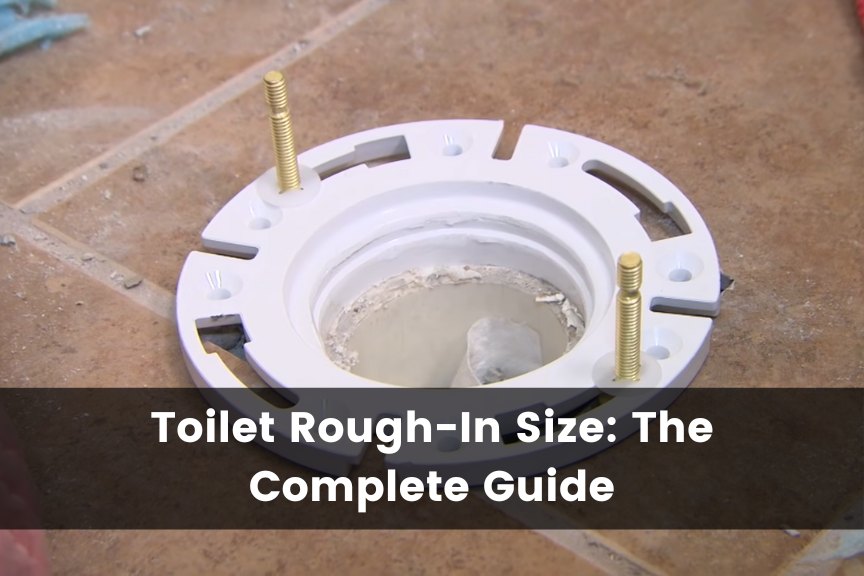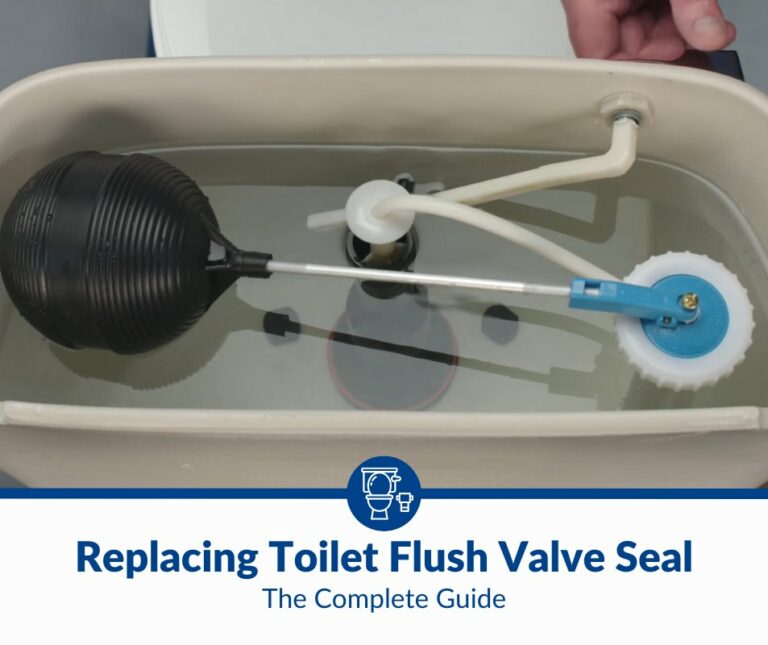Toilet Rough-in Size: The Complete Guide
Have you ever gone to buy a toilet only to find out that it’s the wrong rough-in size? No? Just me? Well, let me tell you, it’s a nightmare.
It’s not only because you wasted time getting the wrong toilet, but also because, for sanitary reasons, you can’t return a toilet once you’ve opened it.
The most common toilet rough-in size is 12 inches. However, toilets also come in 10-inch and 14-inch rough-in sizes. That’s why it’s essential to take accurate measurements before you go on and buy a new toilet.
In this article, you’ll know everything about a toilet rough-in size and how to measure it. So, keep reading for all the details!
What Is a Toilet Rough-in Size?
The rough-in size is the distance between the finished wall where you’ll be placing your new toilet and the center of the toilet’s drainage pipe. It’s also known as the toilet flange.
A toilet rough-in also refers to the overall clearance around the toilet seat and tank.
This rough-in distance ensures that there’s enough space for you to place your toilet correctly. The space should fit the back of the toilet, with the tank resting right against the wall.
Therefore, the next time you think about renovating your bathroom, make sure to measure the toilet rough-in dimensions accurately.
Why Is a Toilet Rough-in Measurement Important?
Whatever it is that you want to do with your bathroom, you’ll always need to measure the toilet rough-in. Measuring the rough-in is essential for many reasons:
- The selection and installation of a new toilet depend on it.
- It’s essential for replacing your old toilet.
- How much free space is in your smaller bathroom depends on your ability to minimize the rough-in size.
- Your bathroom remodeling project relies on rough-in sizing.
- Adding a whole new bathroom to your house also requires it.
What Is the Standard Toilet Rough-in Size?
The standard rough-in size in most houses is 12 inches. In some cases, this distance can be shorter or longer, depending on how old your house is. So, don’t just assume that your toilet’s rough-in size is 12 inches.
Some older houses come with a 10-inch or 14-inch rough-in size plumbing.
Additionally, you may find a 10-inch rough-in size only in smaller bathrooms or half baths, which was basically chosen to save space.
10-inch Rough-in
A 10-inch toilet rough-in is most common in older residential units and houses. It’s considered the smallest rough-in size ever, and you’ll never find anything smaller.
That said, it’s still used nowadays. In fact, a 10-inch toilet rough-in is your ideal option if you want to save space.
12-inch Rough-in
As mentioned before, a 12-inch toilet rough-in is the most popular option at the moment.
Due to the fact that it’s the standard measurement, the toilets of these models are much more affordable and available than the other two types.
14-inch Rough-in
When it comes to 14-inch rough-in size, finding a suitable toilet might be a hard task.
Fortunately, two-piece toilets are flexible, and you can adjust them to whatever rough-in dimensions you have. Otherwise, you’ll have to place a special order for this specific size.
How To Take Toilet Rough-in Measurement?
Taking toilet rough-in measurement isn’t rocket science. It’s easy to do by yourself. All you need to have is a measuring tape, painter’s tape, and sometimes, an erasable marker.
There are two scenarios when it comes to taking toilet rough-in measurement:
Scenario 1: There’s No Existing Toilet
Measuring a toilet rough-in size is much easier when there’s no existing toilet. That’s because you can easily spot the location of the flange opening, unlike when there’s a toilet concealing it.
However, sometimes the bathroom is too small to know which wall you’re measuring against.
It’s a common issue, but it’s quite easy to spot. The target wall is usually the one that has a water supply line. All you need to do is look for a small knob sticking out 2–10 inches above the ground and voila, there’s your back wall!
Here’s how to measure a toilet rough-in when there’s no toilet installed:
- Determine the location of the drain pipe.
- It looks like a round hole in the floor where the old toilet used to be (or where you need to install the new toilet).
- Measure the distance from the finished wall to the center of this hole.
- Don’t place the start of your measuring tape on the baseboard; if there’s one, move it up to the finished wall instead.
- If the bathroom is yet to be finished, and there are only stud walls standing, add the thickness of the finished wall to the measurement.
- Approximately, the thickness is half an inch more because most people install half-inch dry walls in their bathrooms.
- Double-check the results, as they should be 10, 12, or 14 inches.
- If that isn’t the case, there could be something incorrect with the way you took those measurements.
If you’re completely sure you took the right measurements and it’s not 10, 12, or 14, you might need to replace the flange with something called “an offset flange.” It can move the opening by one inch in any direction.
Scenario 2: There’s an Existing Toilet
If there’s a toilet already in place, determining the location of its flange opening could be challenging.
That said, there are three types of toilets, each with a different drainage location. Consequently, there are three different methods to measure their rough-in, which are:
Measuring Standard Toilets Rough-in
You must be thinking, how could I possibly measure the toilet rough-in without being able to see the drainage location? Well, there are certain types of toilets where you can see the trapway path by looking at the toilet from the side.
Additionally, most of the toilets have bolts at the base and their caps are mostly visible. This makes your job measuring the toilet rough-in simpler. Here’s what you should do:
- Allocate where the bolts that hold your toilets to the floor are. (They should be visible from the side view.)
- If the toilet is skirted, meaning that it has a smoother side that covers up all the curves you see on a standard toilet, there should be a fixing screw on each side.
- Each one of these screws is an indication of where the center of the drainpipe is.
- Measure the distance from the finished wall to the center of these bolts, and you’ve got the toilet rough-in size.
- If you find it easier for you to measure on the floor, consider the thickness of the baseboard and add it to the overall distance.
- Double-check the measurements; as mentioned before, the size should fall anywhere between 10 and 14 inches.
Measuring Corner Toilets Rough-in
Measuring a corner toilet rough-in is a bit more complicated than roughing in a standard toilet. However, it’s not too hard.
Here’s what to do:
- Determine where the toilet is bolted to the floor.
- Just like a standard toilet, a corner toilet should have two bolts, one on each side.
- The drainpipe or flange opening’s location is right in the middle between those two bolts.
- Mark the location of the drainpipe on top of the toilet using painter’s tape or an erasable marker for an easier measuring process.
- It should be somewhere between the toilet seat and the tank.
- Measure the distance from the center of the drainpipe to the wall from each side at a perpendicular angle.
- That’s easier than measuring the distance between the center of the pipe and the corner where the walls meet.
- The rough-in size is the distance you measured, and it should be 10–14 inches.
Measuring Wall-mounted Toilets Rough-in
In wall-mounted toilets or rear-outlet toilets, as their name suggests, the drainpipe runs through the wall. Therefore, you’ll have to measure the toilet rough-in vertically, from the floor up to the center of the flange.
A wall-mount toilet rough-in size is different from standard toilets.
It varies in size, which starts from only four inches. It’s usually clarified on the product specifications sheet.
Measuring Toilet Clearance
Another essential dimension you should know before installing a new toilet is the clearance for the tank and the seat on each side of the toilet. You need to make sure that there are at least 15 inches of clearance to the left and right of the drainpipe.
Additionally, you need to measure the space in front of the toilet to make sure that any person is able to sit on it comfortably. According to where you live, it could be illegal not leaving enough clearance space around the toilet.
Note: It’s crucial to check your local plumbing codes before attempting to make any kind of changes, just to ensure compliance.
Measuring the Left and Right Toilet Clearance
You measure the clearance exactly as you do with the toilet rough-in:
- Place the tip of your measuring tape against the adjacent finished wall.
- If there’s anything in the way like a bathtub, vanity, or sink, place the tip of the measuring tape on whatever there is instead of the wall.
- Adjust the tape so that it becomes perpendicular to the flange.
- Check for 15 inches or more of clearance on each side of the flange, starting at the wall and down to the center of the drainpipe.
Note: The National Kitchen and Bath Association recommends a 16-inch clearance on each side, but 15 inches is the absolute minimum.
So, as long as you have the minimum clearance, you have enough space to install your desired toilet.
Measuring the Space in Front of the Toilet
Leaving a clearance distance in front of the toilet is not as crucial as the clearance on the sides or back of the toilet. You only need to make sure that there’s enough room to sit. Twenty-one inches is the minimum room you need for an average person to sit comfortably on a toilet.
That’s in case your local jurisdiction is under the International Plumbing Code (IPC).
Yet, if your area falls under the Uniform Plumbing Code (UPC), you’ll need about 24 inches of clearance.
So, here’s how to measure it:
- Place the tip of your measuring tape at the center of the flange opening.
- Pull the measuring tape out until it reaches 21 inches.
- Add half the length of your toilet base to 21 inches to make sure that you have 21 inches of free space in front of the toilet.
If the length of your toilet base is 20 inches, then the clearance you need to measure from the center of the flange is 21+10 inches, which is 31 inches in total.
Additionally, if the bathroom door is located in front of the toilet, you don’t need to measure the clearance to the open door. That’s because when using the bathroom, we typically shut the door before sitting.
Determining the Location of the Cold Water Supply Line
If you’re installing a whole new bathroom, it’s best to place the cold water supply line 7 inches above the finished floor. That’s to avoid making any trimming in the baseboards if present.
However, if you’re replacing your old toilet, you shouldn’t worry much about it.
In general, base molding can be as high as 5 ¼ inches. That’s why 7 inches up is the perfect place for a cold water supply line.
So, to measure the most ideal place for it, go six inches to the left from the center of the flange opening, then 7 inches up above the finished floor.
Other Toilet Dimensions to Keep in Mind
There are a few other dimensions you should be aware of before purchasing a new toilet to ensure that it fits properly inside your bathroom, which are:
Toilet Seat Height
The total height for any given toilet seat doesn’t include the lid and seat. Measuring from the floor up, the standard height for toilet seats is typically 15 inches. However, this height varies depending on who’s going to use the toilet.
Higher toilet seats are usually much more comfortable and easier to use for disabled people, tall people, and seniors. These specifically-designed toilet seats typically measure between 17–19 inches high.
In addition, if you’ve ever seen a children’s bathroom, you’ll find that the toilets in there are much smaller than the ordinary ones. Children’s toilet seats can be as low as 11.75 inches.
Bowl Dimensions
Toilet bowls come in two shapes, round and elongated. A round-shaped bowl is great for a smaller bathroom, while an elongated one offers much more comfort.
Generally, the elongated shaped bowl is the most used shape in commercial applications.
A toilet bowl measures about 14 inches in width. As for the length, toilet seats vary depending on their shape. A round-shaped bowl is typically 16–17 inches long, while an oval-shaped bowl is 18–19 inches long.
The length of the bowl is usually measured starting from the mounting holes located on the seat and out to the tip of the bowl’s rim.
Tank Height and Width
The toilet tank height is the distance between the top of the tank and the finished floor. Typically, it depends on what type of toilet you have.
A standard height for a toilet tank is 21–31 inches.
With two-piece toilets being mostly higher than one-piece toilets, they rarely exceed the 32-inch limit. As for the width, there’s no uniform code stating how wide toilet tanks should be, but in general, they don’t exceed 20 inches.
Can You Install a 10-inch Rough-in Toilet Over a 12-inch Rough-in Opening?
Yes, it’s possible.
You see, installing a smaller toilet on a bigger rough-in size should pose no problems other than the fact that there will be a gap between the back of the toilet and the wall. So, it might look bizarre, but it would still function properly.
The only thing to consider is the shutoff valve location. It may need a longer connector to effectively reach the tank. Plus, you’ll need to reach your hand 2 inches further back to grab the toilet paper roll.
That said, how about if you reversed the question? Would it still be possible?
Installing a bigger toilet on a small rough-in opening is practically impossible. That’s because the space won’t fit the toilet, and the drainpipe won’t be aligned with the toilet outlet.
Conclusion
Now that you know everything about toilet rough-in size, the next time you go and buy a toilet, you’ll know exactly what to look for.
Most modern toilets come with a 12-inch rough-in, but 10-inch and 14-inch rough-in toilets are still available.
You also need to keep in mind the side clearance, front spacing, and cold water supply line. These dimensions are essential because some toilet models are bigger or more elongated than others.
So, before you go ahead and renovate your old bathroom or just replace the toilet, make sure that you’ve got all your measurements right, especially if your house is a bit old.
Doing so saves you time as well as repair money in the future!







